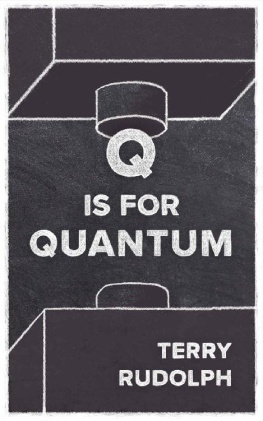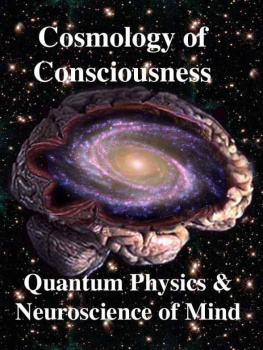Terry Rudolph - Q is for Quantum
Here you can read online Terry Rudolph - Q is for Quantum full text of the book (entire story) in english for free. Download pdf and epub, get meaning, cover and reviews about this ebook. year: 2017, publisher: Terence Rudolph, genre: Children. Description of the work, (preface) as well as reviews are available. Best literature library LitArk.com created for fans of good reading and offers a wide selection of genres:
Romance novel
Science fiction
Adventure
Detective
Science
History
Home and family
Prose
Art
Politics
Computer
Non-fiction
Religion
Business
Children
Humor
Choose a favorite category and find really read worthwhile books. Enjoy immersion in the world of imagination, feel the emotions of the characters or learn something new for yourself, make an fascinating discovery.
- Book:Q is for Quantum
- Author:
- Publisher:Terence Rudolph
- Genre:
- Year:2017
- Rating:3 / 5
- Favourites:Add to favourites
- Your mark:
- 60
- 1
- 2
- 3
- 4
- 5
Q is for Quantum: summary, description and annotation
We offer to read an annotation, description, summary or preface (depends on what the author of the book "Q is for Quantum" wrote himself). If you haven't found the necessary information about the book — write in the comments, we will try to find it.
Q is for Quantum — read online for free the complete book (whole text) full work
Below is the text of the book, divided by pages. System saving the place of the last page read, allows you to conveniently read the book "Q is for Quantum" online for free, without having to search again every time where you left off. Put a bookmark, and you can go to the page where you finished reading at any time.
Font size:
Interval:
Bookmark:
Q
is for
QUANTUM
Terry Rudolph
Terry Rudolph, 2017
All rights reserved. Without limiting the rights under the copyright reserved above, no part of this publication may be reproduced, stored in, or introduced into a retrieval system, or transmitted in any form or by any means (electronic, mechanical, photocopying, recording, or otherwise) without prior written permission. While every effort has been made to ensure the accuracy and legitimacy of the references, referrals, and links (collectively Links) presented in this book, the author is not responsible or liable for broken Links or missing or fallacious information at the Links. Any Links in this book to a specific product, process, website, or service do not constitute or imply an endorsement by T. Rudolph of same, or its producer or provider. The views and opinions contained at any Links do not necessarily express or reflect those of T. Rudolph. Particularly the ones on interpretations of quantum theory.
For permission requests, please contact:
ISBN: 978-0-9990635-0-7
www.qisforquantum.org
Cover design by Chris Van Diepen, createwithbodhi.com
Interior design by booknook.biz
For Xavier, Aby, Lydia, Jesse and Caleb
TABLE OF CONTENTS
Preface
This book has been written for my 15-year-old self. Well, there is plenty of advice I would give my 15-year-old self that you dont want to hear, and there are very many things I was very interested in at 15 that are not covered here. But one thing I was interested in at that age was science, and I distinctly recall being frustrated by the lack of concrete explanations within pop-sci accounts of modern physics. The exciting descriptions I found in them were ultimately hollow. They were vague on details and they came loaded with jargon, questionable analogies, and somewhat mysterious pontifications about the nature of physical reality. Implicitly justifying the lack of explanation were historical anecdotes about how these discoveries confused all the famous physicists who made them as well.
As someone who wanted to tackle these mysteries (perhaps solving them before I left high school!) the situation was frustrating. Having failed to solve the mysteries by 17, I was forced to go and waste years studying physics at university. The failures kept piling up, and I have ended up a professional physicist who is still both confused and amazed by our physical laws.
A fairly recent mathematical breakthrough (not by me) suggested a very different method of presenting some of the most interesting and weird phenomena of modern physics. Through my talks to teenagers I have found it is possible for students who know only arithmetic to quantitativelynot just qualitativelyunderstand the most important features of many of our deepest confusions about what is going on in the natural world. In fact, my nine-year-old nephew understood why there is a genuine mystery about what could really be happening inside the PETE boxes introduced in Part I and a few days later asked me whether I have solved it yet. Perhaps he wanted to solve it himself before leaving primary school.
I eventually decided to write down the method I use, and here it is. Of course it is very much easier explaining this kind of thing in the back-and-forth dialogue of a classroom. It would be awesome if high-school teachers got interested in this approach and felt comfortable enough to explain these wonderful things to their students. I welcome feedback about what other resources I could provide to facilitate this.
Introduction
This is a book about physical phenomena I find deeply mysterious; about how we plan to harness them in amazing new technologies despite not really understanding them; and about where we stand in our attempts to obtain such an understanding.
We use mathematics to help us describe things going on in the physical world around us. This is not only because quantitative statements (which are precise and technical, such as: If you fall out of a tree twice as high it will take 1.4142 times as long to hit the ground, regardless of the tree height or what size planet you are on) are more useful than qualitative ones (which are fuzzy and vague, such as: Well, duh, itll take longer becoz the tree is higher, which planet are you on?). Rather, to a physicist, the math is an inextricable part of our understanding. Many times we have successfully predicted the existence of new physical objects and new physical phenomena based on the math alone.
The mathematical equations of physicsthe physical lawstypically provide us with precise and beautifully intricate rules by which we understand how physical things we either observe directly, or otherwise believe exist, connect to each other. This lets us build a story, a narrative, about what is really going on. It does sometimes happen, however, that we are uncertain about the exact connection between the useful math and the physical world. For example, prior to the direct observation of atoms, some doubted their existence for this sort of reason.
Modern physics is in an odd situation. Some of our most important physical laws lead to a very strange (many would say completely nonsensical) narrative about what is actually going on when we view the mathematical objects in the theory as corresponding to something physically real.
More precisely then, this is a book about the tension between the abstract math, the observed physics, and the inferred story. Along the way the goal is to elucidate both strengths and limitations of some of the very cool new technologies we are currently building based on these incompletely understood laws.
Unfortunately, not everyone is good at mathematics, and most have little, if any, training in physics. So to tell the remarkable story of this ongoing intellectual adventure and the controversy around it, I (and many others) typically have resorted to qualitative expositions. These are very, very limited, and appreciating them alone simply will not let you make a meaningful contribution to the discussion, despite many emails I receive from crackpots suggesting the contrary. It is like only having van Goghs Starry Night described in words to you, by someone who has only seen a black and white photograph. One that a dog chewed.
I recently came to the realization that it is possible to do much better than this. I believe I can help you properly understand most of the mysteries that swirl around our abject failure to take some mathematical equationswhich unquestionably describe experiments we can doand underpin them with a universally accepted physical narrative.
Nominally, the only math required in this book is the arithmetic of positive and negative integers. But in fact the drawings you will see in subsequent pages are mathematics. They are symbols on paper that we manipulate according to fixed rules, which have subtle relationships with each other, and which act as shortcuts for much longer and wordier descriptions. All math is really just this. What I am doing with all these drawings is what theoretical physicists do for a livingplay around with numbers and equations and diagrams to try to describe certain things that we observe (or suspect) happen. When we find some that seem to explain the situation consistently, we are delighted if puzzled, and use them to do more complex calculations pertaining to related happenings. As long as the outcomes fit with the observations, we feel somewhat happy with our equations. But ultimately we would like to feel we really understand what our mathematics means in terms of stuff that actually goes on in the physical world.
I begin in Part I by presenting some simple but amazing experiments we can do, building up the math we use to describe them. From this I will be able to show you how we will soon build new types of computers, ones that think using a logic very differently to ours. We can do this even though we dont have a deep understanding of what is going on inside them at the underlying physical level. In Part II we will tackle the strange phenomena of nonlocality and entanglement; for me these were the gateway drug to physics. In Part III we go on a trip that may make you wonder if physicists are on other kinds of drugs too, as we explore the strong incompatibility between the physical realism we simply take for granted, and any sensible narrative about what is actually going on.
Next pageFont size:
Interval:
Bookmark:
Similar books «Q is for Quantum»
Look at similar books to Q is for Quantum. We have selected literature similar in name and meaning in the hope of providing readers with more options to find new, interesting, not yet read works.
Discussion, reviews of the book Q is for Quantum and just readers' own opinions. Leave your comments, write what you think about the work, its meaning or the main characters. Specify what exactly you liked and what you didn't like, and why you think so.












